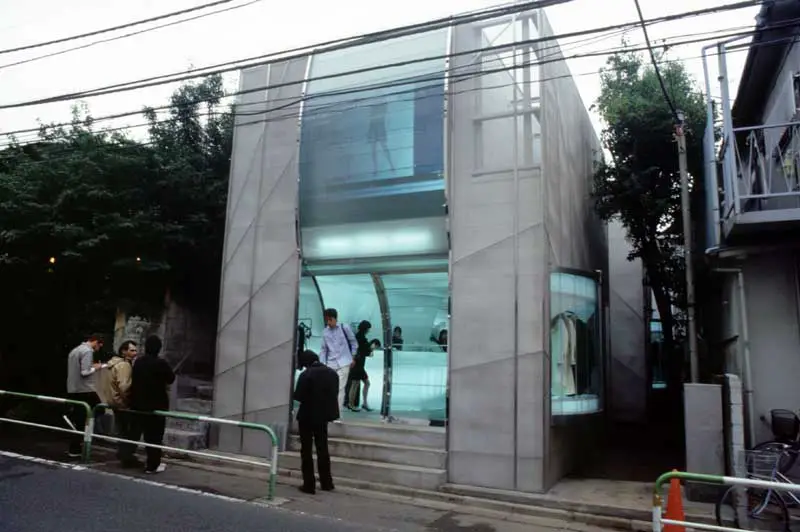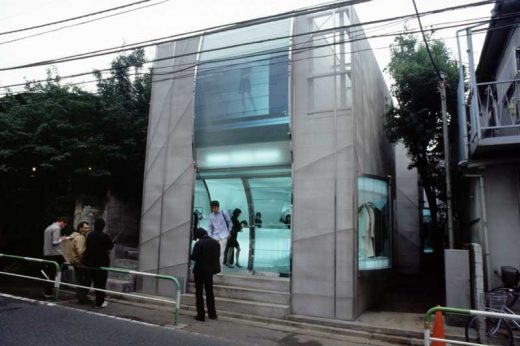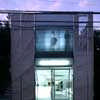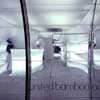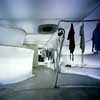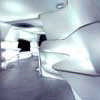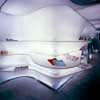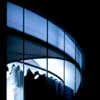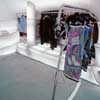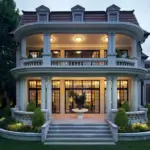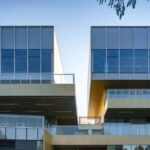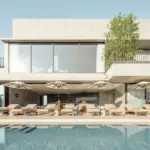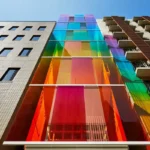United Bamboo Store Tokyo, Daikanyama, Images, Building, Clothing Boutique
United Bamboo Store, Tokyo : Daikanyama Shop
Tokyo Clothes Shop, Japan – design by Acconci Studio, architects
1 May 2008
United Bamboo Tokyo Store
Location: Daikanyama, Tokyo
Date: 2003
Architects: Acconci Studio
Materials: Steel mesh, steel pipe, faceted glass, PVC projection material, fluorescent lights, photo-booth camera, computer screen, video projection, iPods & headphones
Area: 620 sqft
Contractor: TONY
United Bamboo Tokyo
SITE: An existent two-story building on a narrow street of closely-spaced buildings, many of them recently turned into clothing stores; squeezed into its small lot, the building is closed in on by overgrown shrubbery and weeds. The second floor is narrower than the first, with a balcony at one side; the building is clad in white modular stucco panels – it bespeaks what it used to be, a residence.
PROJECT: An Old Building Re-clothed. The exterior of the building is given a second skin: a screen of stainless-steel mesh that encloses the balcony and re-shapes the building; the framework crosses the mesh in diagonals, radiating from some unknown point and traveling around the building, re-orienting the building.
A Glass Façade Breaks Through The Screen. It bulges into the first floor, which houses the store; it’s as if it pulls back to accept you — past mirrored side-walls, which mix inside and outside, you walk through a sliding door. The glass façade bulges out from the second floor, which houses the office and showroom; projected on the upper façade, out to the street, are images of people in clothes from the store.
A Clothing Store As Soft As Skin. The interior resembles fabric, like the clothes in the store; it’s PVC sheeting, rear-projection screen. The PVC is pulled down, arched down, from the ceiling onto the walls; it’s pulled out from the walls, and pushed back in, to make shelves — it’s pulled out and around to make a counter. At the front of the store, the PVC is pulled up from the ceiling, over the second floor façade; it makes the projection screen.
A Store On The Surface, A Store That’s All Surface. The skin glows from within; light from fluorescents, behind the PVC, is diffused throughout the store. The clothing is lit from above and behind; the surface lights the store.
The Skin Hides The Bones. The structure of the old building is subsumed into new functions. At the edge of the store, PVC from the ceiling is pulled down around columns, and pulled out to make shelves for CD’s. Further within, each of two columns is concealed inside a three-sided mirror; three people can look at themselves, individually, at the same time and in the same space.
Clothes In The Jungle. The small store bulges out of itself; the non-structural walls of the old building are removed, and curving glass alcoves push out into the weeds and overgrown shrubbery around the store. A rack of hanging clothes is stored inside each alcove, apart from the confines of the store, and inserted within the miniature jungle outside – you look at clothes against a background of jungle; you take a piece of clothing out from the jungle.
The Performance Of Clothing. PVC from ceiling and walls is pulled back into the glass alcoves; it slopes down and up, above and below hanging clothes, and makes a stage for them. The racks extend inside the store; the hanging clothes have moved in from outside. As customers weave around the racks, in and out of nooks, as they take time to move through the store, the small store feels larger.
Like Changing Clothes. From either of the three-sided mirrors, you can pull out PVC, on floor and ceiling tracks, and draw it around you to make a dressing room. Two mirrors land inside the dressing room, while one remains outside, for casual viewing. A panel pivots down from one mirror: inside the dressing room, it makes a shelf – when there’s no dressing room, you might sit here and wait for a friend who’s shopping. Two more seats are folded up into flattened triangles and hung on the racks; you take one down and bring it where you want, to try on shoes.
Floating World. The edges of the concrete floor are cut short of the walls, leaving a gap around the store; the PVC drops away, disappears, into a channel of light around the store. The channel of light branches off from the sides into the middle: around the counter, around the deployable dressing room, under the hanging clothes as they veer out of the glass alcoves.
Clothing As Decoy. The end of each hanging rod curves down into a vertical post that’s pressed and flattened to hold an iPod with headphones; they make a listening station for the CD’s sold in the store. The store does not exist for clothes alone; the clothes sell a life-style.
Looking At Yourself Through Others. A leftover space between structural walls, too small for shelves, is turned into a mirrored niche. Two vertical mirrors touch at right angles, while a horizontal mirror above slopes down inward; inside the niche, you can see yourself from the sides and from above. If you stand back and look into the middle, between mirrors, your image is non-reversed; it’s as if you’re facing another person. Two people, standing in front of each mirror, look at themselves through each other’s gaze.
Fashion without models. If you like how you look, in the clothes you might buy, you can have yourself photographed; you activate a device that operates a camera, behind the mirror. It’s you who appears on the store façade, facing the street; you’re wearing the clothes you want, you’re looking good, you testify for United Bamboo.
Acconci Studio (Vito Acconci, Julia Loktev, Peter Dorsey, Stephen Roe, Sehzat Oner, Larry Sassi, Dario Nunez, Gia Wolff, Laura Charlton)
United Bamboo Store Tokyo – images / information from Acconci Studio May 2008
United Bamboo Store Tokyo architects : Acconci Studio
Location: Daikanyama, Tokyo, Japan
Tokyo Architecture
Tokyo Architecture Selection
Tokyo Architecture Designs – chronological list
Tokyo Building Designs – Selection
Ota Art Museum & Library, Gunma Prefecture
Architects: akihisa hirata architecture office
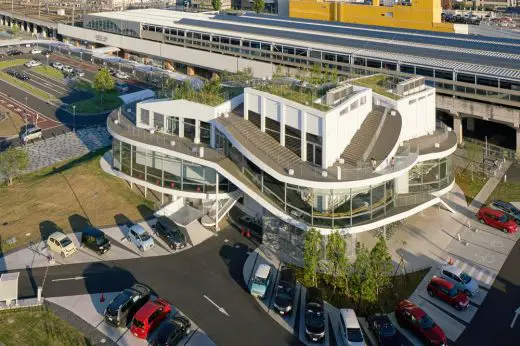
photo : Daici Ano
Ota Art Museum & Library Building
Prada Store
Herzog and de Meuron
Prada Store Tokyo
Kindergarten
Satoshi Ohtaki
Tokyo Kindergarten
Japanese architect : Toyo Ito
Comments / photos for the United Bamboo Store Building page welcome
United Bamboo Store Tokyo
Website: Tokyo, Japan

